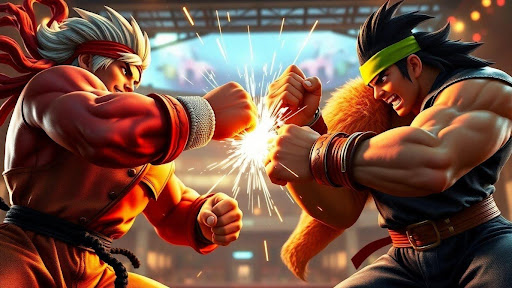Why Meme Characters and Combo Timing Matter More Than You Think

The Allure of Flashy Combos
When people first get into fighting games, they often see the flashy, long combos in trailers and online videos. It’s easy to think that mastering these intricate sequences is the main goal. This perception is understandable, as marketing often highlights these impressive displays of skill. It makes the games look exciting and deep.
However, this focus on complex combos can be a major turn-off for newcomers. They might feel overwhelmed, believing they need to memorize dozens of button presses before they can even play. This creates a barrier to entry, making the genre seem more difficult than it actually is. The idea that you must do these long combos to win is a common misconception.
While combos are important for maximizing damage, they aren’t the only path to victory. Many players get stuck trying to learn these elaborate strings without first grasping the basics. Without a solid foundation, even the most practiced combo can be difficult to land in a real match. It’s like trying to build a house without a solid foundation.
Combos Are Not Always The Key to Victory
Many new players get discouraged because they believe they need to learn long, complicated combos to be competitive. This isn’t usually the case, especially when starting out. The focus on combo execution can overshadow more important skills that lead to wins.
It’s true that combos deal the most damage, but what good is that if you can’t even hit your opponent? Many players spend hours in training mode perfecting a 10-hit combo, only to struggle with basic movement or defense in an actual match. This is a common pitfall that can slow down progress.
Instead of chasing the longest combo, focusing on simpler, more reliable attacks and specials can be far more effective. Landing a few well-timed basic hits into a special move can often secure a win more consistently than attempting a risky, complex combo. The goal is to win the match, not just to perform the most stylish sequence.
The Importance of Foundational Skills
Many players mistakenly believe that mastering long combos is the most important aspect of fighting games. This focus can be misleading, especially for those new to the genre. The flashy nature of combos in promotional material often creates this impression.
However, skills like blocking, spacing, and punishing are far more critical in the early stages of learning. These foundational elements allow players to survive and create opportunities. Without them, even the most practiced combo is unlikely to be landed effectively.
Focusing on these basic skills first will build a stronger understanding of the game. It allows players to react to their opponent and control the pace of the match. This approach is often more rewarding and less intimidating than trying to memorize complex combo strings from the start. A solid understanding of fundamentals is key.
Mastering the Fundamentals of Engagement
The Power of Punishing and Anticipation
Many players get caught up in flashy combos, but the real game-changer is understanding how to punish mistakes. This means watching your opponent, seeing when they overextend or miss an attack, and knowing the right move to hit them back. It’s about playing smart, not just fast.
Anticipation is key here. If you can predict what your opponent will do next, you can set up your own offense or defense. This isn’t about reading minds, but about recognizing patterns and common habits. A well-timed block or a quick jab can stop an opponent’s attack in its tracks, giving you the opening you need.
Learning to punish effectively is more important than executing a long, complex combo. It’s the foundation of solid play. Focus on these moments, and you’ll see a big difference in your matches. This approach to engagement is what separates good players from great ones.
Effective Use of Basic Attacks and Specials
Don’t underestimate the power of your basic attacks, often called normals. These are your bread and butter for controlling space, poking at your opponent, and starting pressure. Knowing which normal to use in different situations is a skill in itself. A quick jab might be good for interrupting, while a longer-reaching normal can keep your opponent at bay.
Special moves are powerful tools, but they often come with risks. Using them at the wrong time can leave you open to punishment. The trick is to use them when you have a clear advantage or when you’ve baited your opponent into a mistake. Canceling a normal attack into a special move can also be a great way to extend pressure or surprise your opponent.
Think about it like this:
- Normals: Your everyday tools for most situations.
- Specials: Your heavy hitters, used strategically.
- Combos: Stringing moves together for maximum damage, often starting with a normal or special.
Mastering the timing and range of your basic attacks and specials is a huge step. It allows for more consistent pressure and better defensive options.
Understanding Defensive Maneuvers
Defense is just as important as offense in fighting games. Knowing when to block, when to jump, and when to use defensive special moves can save you from taking a lot of damage. Blocking is the most basic defensive tool, but knowing when to block and for how long is crucial.
Sometimes, the best defense is a good offense, but that doesn’t mean ignoring your defensive options. Using a well-timed invincible move or a quick counter-attack can completely turn the tables. It’s about creating a balanced game plan where you’re not just waiting to attack, but also prepared to defend.
A solid defense means you’re always in the game, ready to capitalize on any opening. It’s about survival and creating opportunities.
Learning to block correctly, understanding your character’s defensive options, and knowing when to disengage are all vital skills. These defensive maneuvers are what keep you in the fight and allow you to learn from your opponent’s approach.
Character Selection and Its Strategic Impact
Beyond the Combo Potential
Picking a character isn’t just about how cool their moves look. It’s about finding someone whose playstyle fits you. Some characters are built for aggressive rushes, while others excel at keeping opponents at a distance. Don’t get too caught up in the idea that only characters with long combo strings are worth your time. Many characters have simpler, yet highly effective, game plans.
Think about what kind of player you are. Do you like to control space? Do you prefer to get in close and pressure your opponent? Your character choice should reflect that. A character that feels good to play, even if their combos aren’t the flashiest, will likely lead to more consistent wins.
The right character can make learning the game much more enjoyable. It’s about finding that connection, that feeling of control, rather than just chasing the highest damage numbers.
Character Aesthetics and Mechanical Appeal
Sometimes, a character just looks cool. That visual appeal can be a big motivator. If you like how a character moves, how they attack, and their overall design, you’re more likely to spend time learning them. This mechanical appeal goes hand-in-hand with aesthetics.
Does a character’s move set feel intuitive to you? Do their special moves have a satisfying impact? These subjective elements play a huge role in player engagement. A character might have amazing combo potential on paper, but if their basic attacks feel weak or their movement is clunky, it can be a real turn-off.
It’s a balance. You want a character that looks good and feels good to play. This combination is key to sticking with a character long-term.
The Role of Character Archetypes in Playstyle
Fighting games often group characters into archetypes, like “zoners,” “rushdown,” or “grapplers.” Understanding these archetypes helps you predict how a character is meant to be played and how they might match up against others. A zoner, for example, wants to keep you far away with projectiles, while a rushdown character wants to get in your face.
Knowing these roles helps you understand your own character’s strengths and weaknesses. It also gives you insight into your opponent’s likely strategy. If you’re playing a rushdown character, you need to find ways to close the distance against a zoner.
Choosing a character isn’t just about their moves; it’s about choosing a strategy. The character you pick dictates how you approach the game and interact with your opponent.
This understanding of character archetypes is a big part of developing your own playstyle. It helps you make informed decisions about who to play and how to play them effectively. It’s a core part of the strategic depth in fighting games.
Navigating the Learning Curve of Fighting Games
Demystifying Combo Trials
Many fighting games present combo trials as a gateway to mastery. However, these often jump from simple moves to incredibly complex sequences with very tight timing. This can be a major turn-off for new players. It feels like you’re just fumbling around, even with basic actions. The games make it look easy, but the reality is often a struggle.
The sheer difficulty spike in combo trials can be intimidating. Players might nail a single move but fail to string together even a three-hit sequence. This isn’t always about player error; sometimes, the game’s input notation can be misleading. What looks like a simple directional input might require a precise diagonal press.
It’s a common experience for players to get stuck early on. This frustration can lead them to abandon the game before they even grasp the core mechanics. The focus on complex combos from the start can overshadow the importance of simpler, more effective strategies.
The Fear Factor for Newcomers
New players often feel overwhelmed. They see intricate combos and advanced techniques and assume they need to master all of it to compete. This perception creates a significant barrier to entry. Many might try a game, get stuck on the initial learning steps, and then decide fighting games just aren’t for them.
This intimidation is a real problem. It’s not uncommon for players to feel like they’re just clumsy, even when trying to perform basic actions like blocking or executing a simple special move. The pressure to perform complex inputs can be paralyzing.
This fear can lead to players avoiding matches or sticking to single-player modes, never truly engaging with the community or the competitive aspect of the genre. It’s a shame because the core gameplay can be very rewarding.
Accessible Entry Points for Beginners
Instead of diving straight into complex combos, beginners should focus on the basics. Learning to cancel normals into specials is a great starting point. This skill helps with other fundamental aspects like blocking and poking. It’s about building a solid foundation.
Many players get stuck trying to replicate flashy moves they see in tournaments or combo videos. This approach often leads to frustration. A more effective strategy is to focus on simple, repeatable actions. Keep it simple, stupid, as the saying goes.
Prioritizing basic controls and game functions over lengthy combos is key. Anticipating an opponent, blocking, and punishing with a simple attack into a special move can win more matches than attempting a long, difficult combo. This approach makes the learning process more manageable and enjoyable.
The Art of Timing in Meme Wars

Strategic Timing Over Complex Execution
Forget those super long, flashy combos you see online. In the real game, especially when things get heated, it’s all about smart timing. Knowing when to press your advantage and when to play it safe makes a huge difference. It’s not about memorizing a hundred button presses; it’s about understanding the flow of the match.
That’s exactly the kind of strategy-focused gameplay that makes Meme Wars on MemeWars.gg stand out among arena fighters.
Think about it: a perfectly timed block can stop an opponent’s most dangerous attack. A quick jab at the right moment can interrupt their plan. This kind of timing is what separates players who just mash buttons from those who actually control the fight. It’s about making your moves count, not just making a lot of moves.
The most effective players often rely on simple, well-timed actions rather than complex, risky sequences. This approach is more consistent and less prone to mistakes, especially under pressure. It’s a lesson many learn the hard way.
Adapting to Opponent’s Patterns
Every player has habits. Some jump too much, others always block after a certain move. Learning to spot these patterns is key. When you see an opening, you act. When they make a mistake, you punish it. This back-and-forth is where the real strategy lies.
Observing your opponent is like reading a book. You start to see the recurring themes and predictable plot points. If they always try to grab you after a certain attack, you can anticipate it and counter. This kind of adaptation is what makes matches exciting and unpredictable, even with simple strategies.
Good timing isn’t just about your own actions; it’s about reacting to what the other person is doing. It’s a conversation, not a monologue.
The Value of Consistent, Simple Strategies
It’s easy to get caught up in trying to pull off the most impressive-looking moves. But often, a few reliable, well-timed basic attacks or special moves are far more effective. These simple tools, used with good timing, can consistently chip away at an opponent’s health and control the pace of the game.
Focusing on these core mechanics means you’re less likely to drop a combo or make a critical error. It builds a solid foundation. You can win by consistently applying pressure with smart, timely attacks, rather than relying on a lucky, complex string of moves. This consistent approach is what wins tournaments.
Beyond the Spectacle: Practical Application
Real-World Match Effectiveness
Forget the flashy, impossible-to-land combos for a moment. What actually wins matches? It’s the simple, reliable stuff. Knowing when to poke, when to block, and when to punish a mistake is way more important than a 50-hit string that drops half the time. Players who focus on solid fundamentals, like good spacing and timing, often outperform those who only chase big damage.
The most effective combos are the ones you can actually do. Trying to execute a complex sequence under pressure, when your opponent is actively trying to stop you, is a recipe for failure. Instead, focus on shorter, more consistent strings that you can reliably land. This approach builds a strong foundation for winning.
It’s about making smart choices, not just button presses. A well-timed throw or a simple special move can be far more impactful than a dropped, high-difficulty combo. This practical application of skills is what separates casual play from competitive success.
The Impact of Fundamentals in Tournament Play
In high-level play, the difference between winning and losing is often razor-thin. This is where solid fundamentals truly shine. Tournament players don’t rely on luck; they rely on consistent execution and smart decision-making. They understand the game itself, not just their character’s flashy moves.
Think about it: a player who consistently punishes unsafe moves, controls space, and makes smart reads will often beat someone who only knows a few big combos. This focus on core mechanics means they can adapt to different opponents and situations. It’s about playing the player, not just the character.
This is why even characters with lower combo potential can still be top-tier. Their strengths lie in their neutral game, their defensive options, and their ability to exploit openings. These are the skills that win tournaments, not just the ability to perform a long combo.
Finding Fun in Accessible Gameplay
Fighting games can seem intimidating, especially with all the complex combos and character matchups to learn. But there’s a lot of fun to be had even if you’re not aiming for pro-level play. Focusing on the basics makes the games more approachable and enjoyable for everyone.
When players can win with simpler strategies, it keeps them engaged. It’s not about being the best; it’s about having a good time. Mastering a few key moves and understanding the flow of a match can be incredibly rewarding. This accessibility is key to keeping the community healthy and growing.
Ultimately, the goal is to have fun. Whether you’re pulling off a complex combo or just landing a solid poke, the enjoyment comes from playing the game. Accessible gameplay and a focus on core mechanics allow more people to experience that joy.
It’s Not Just About the Flash
So, while those flashy combos and cool character moves get all the attention, it’s really the basics that build a solid foundation. Learning how to block, when to punish, and just understanding the game’s core mechanics often wins out over memorizing a long string of attacks. Many players get turned off because they think they need to master complex combos right away, but that’s usually not the case. Focusing on fundamentals and timing can take you much further, and it’s a much more approachable way to get into fighting games. Remember, the most practical combo is the one you can actually pull off when the pressure is on, not just the one you practiced in training mode.




